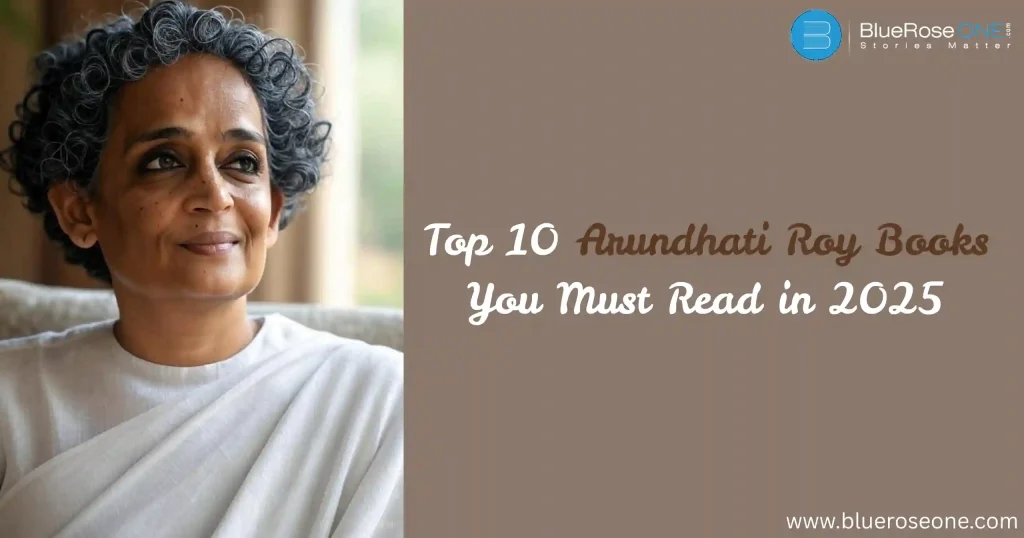
10 Arundhati Roy Books You’ll Regret Missing in 2025
Arundhati Roy is not just an author, she’s a movement. Known for her lyrical prose, unapologetic political voice, and unmatched courage, she has carved her place as one of the most powerful writers and activists of our time.Whether you’re into fiction that grips your soul or essays that challenge your worldview, 2025 is the perfect year to dive into Roy’s influential works. In this article we will explore the top ten arundhati roy books that everyone must read: Why Arundhati Roy Books Still Matter in 2025 Roy’s writing doesn’t exist in a vacuum. She gives voice to those forgotten in mainstream discourse Dalits, Kashmiris, Adivasis, and many others. Her work has only grown more relevant as political unrest, environmental degradation, and media manipulation continue to dominate global headlines. What makes Roy so unique is her seamless blend of storytelling and activism. Her novels are poetic, while her essays are piercing and revolutionary. In 2025, with misinformation at its peak, her honest lens becomes even more vital. You may also like: 150 Useful Tone Words to Describe Tone | Explanation with Examples Here’s a complete list of top ten arundhati roy books of all time 1. The God of Small Things (1997) The God of Small Things (1997) is Arundhati Roy’s Booker Prize-winning debut novel, which earned her international renown. Set in Kerala, the story follows fraternal twins Estha and Rahel as they negotiate a society molded by love, loss, caste, and forbidden relationships. Roy’s lyrical style and non-linear storytelling expose the emotional depth of ordinary tragedies, making this novel a strong and unforgettable read in contemporary Indian literature. You may also like: List of Top 10 Best Rabindranath Tagore Books of All Time The God of Small Things – Arundhati Roy Books 2. The Ministry of Utmost Happiness (2017) Arundhati Roy’s novel The Ministry of Utmost Happiness is a compelling and beautiful look at India’s underprivileged populations. It was published in 2017 and tells multiple stories, with Anjum, a transgender lady, and Tilo, a woman caught up in political instability. Roy expertly weaves personal problems with national disasters, providing a compelling reflection on identity, resistance, and the complexities of modern India. It is a must-read for its emotional depth and beautiful writing. You may also read: 10 Tony Robbins Books That Will Blow Your Mind The Ministry of Utmost Happiness – Arundhati Roy Books 3. Field Notes on Democracy: Listening to Grasshoppers (2009) Field Notes on Democracy: Listening to Grasshoppers is a powerful collection of essays by Arundhati Roy that critically examines the state of democracy in India. Published in 2009, the book explores rising nationalism, communal violence, and media manipulation. Roy draws on real events and sharp analysis to question mainstream narratives, offering a bold voice for marginalized communities. This thought-provoking work remains deeply relevant for readers navigating India’s socio-political landscape in 2025. You may also like: Top Aravind Adiga Books You Must Read Before You Die Field Notes on Democracy – Arundhati Roy Books 4. Capitalism: A Ghost Story (2014) Capitalism: A Ghost Story by Arundhati Roy is a powerful critique of India’s economic and political systems. In this thought-provoking work, Roy explores how corporate power and neoliberal policies have deepened inequality and silenced dissent. Through investigative essays and bold commentary, she exposes the links between capitalism, state violence, and media control. This book is essential reading for anyone seeking to understand the hidden costs of economic growth in modern India. You may also read: Devdutt Pattanaik Book List: Best Mythology Books Ranked Capitalism: A Ghost Story – Arundhati Roy Books 5. Things That Can and Cannot Be Said (2016) Things That Can and Cannot Be Said is a strong political talk between Arundhati Roy and actor-activist John Cusack, featuring revelations from whistleblower Edward Snowden. The book was published in 2016 and delves into subjects such as surveillance, state control, war, and resistance. Roy’s keen assessment of global power structures, along with her fearless voice, make this an engaging and current read, particularly for anyone interested in activism, freedom, and the ethics of dissent. You may also like: The 20 Agatha Christie Books Every Mystery Lover Must Read You may also like: Left Behind Series Books in Order: Where to Begin Things That Can and Cannot Be Said – Arundhati Roy Books 6. Azadi: Freedom. Fascism. Fiction. (2020) Arundhati Roy’s Azadi: Freedom, Fascism, Fiction is a remarkable collection of articles that examines India’s political environment in the face of increasing nationalism. The book, which was published in 2020, examines freedom, dissent, and the role of writers in difficult times. Roy investigates the consequences of the Citizenship Amendment Act, the Kashmir lockdown, and the overall deterioration of democratic norms. Azadi’s powerful commentary invites readers to reconsider justice, identity, and resistance in contemporary India. You may also like: List of Top 10 Nikita Singh Books of All Time Azadi: Freedom. Fascism. Fiction. – Arundhati Roy Books 7. The End of Imagination (1998, republished 2016) The End of Imagination (1998, reissued 2016) is a powerful collection of Arundhati Roy’s early political articles that sharply criticizes nationalism, nuclear policy, and social inequality in India. Roy uses bold, poetic language to question prevailing narratives and give voice to underrepresented communities. This work represents her journey from author to outspoken activist, making it important reading for anybody looking to grasp her changing perspective and uncompromising devotion to the truth. You may also like: Top 10 Ravinder Singh Books You Must Read Now! – #9 Will Blow Your Mind You may also like: 20 Satire Examples in Real-World Every Writer Should Know The End of Imagination – Arundhati Roy Books 8. Listening to Grasshoppers: Field Notes on Democracy (2009) Listening to Grasshoppers: Field Notes on Democracy by Arundhati Roy is a bold collection of political essays that critique the state of democracy in India. Through vivid storytelling and sharp analysis, Roy examines communal violence, inequality, and the erosion of civil liberties. Published in 2009, the book reflects her unwavering commitment to justice and truth, making it essential reading for anyone interested in contemporary Indian…
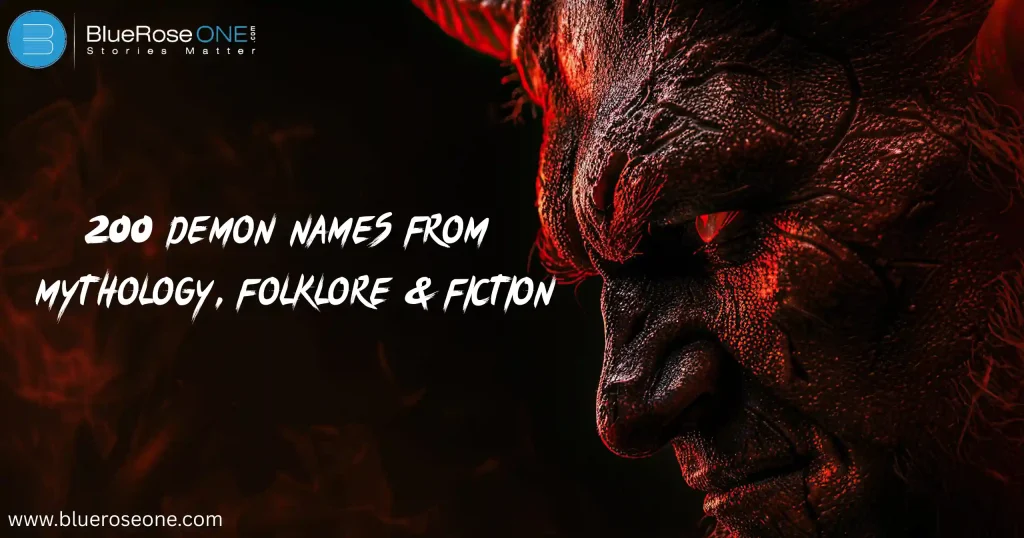
200 Terrifying Demon Names You’ve Never Heard Of!
Ever wondered what lurks behind the veil of myths, scriptures, or horror movies? Demon names have always stirred fascination, fear, and creativity. From ancient scrolls to modern RPGs, these names pop up everywhere. Whether you’re writing fiction, researching folklore, or just curious, this massive A-Z list of 200 demon names will quench your thirst for the arcane. Table of Content What Are Demon Names and Why Do They Matter? Origins in Mythology and Folklore Demon names aren’t just random gibberish from horror tales. Many come from ancient religious texts, pagan traditions, and local legends. Some were once gods, later demonized by rival faiths. For instance: Influence in Modern Fiction and Pop Culture From “The Exorcist” to “Supernatural”, demon names are a staple in fantasy and horror genres. They add mystery, danger, and power to stories. Ever played a game and summoned Paimon or fought Lilith? That’s the power of names. A-Z Demon Names List Let’s take a deep dive into the 200 most intriguing, terrifying, and iconic demon names you’ll ever encounter. Buckle up—this is your infernal dictionary! A-D Demon Names E-H Demon Names I-L Demon Names M-P Demon Names Q-T Demon Names U-Z Demon Names You may also like: The Housemaid Series in Order: A Complete Reading Guide Demon Classifications: Types & Roles Princes of Hell In demonology, the Princes of Hell are powerful rulers who preside over vast legions of demons and hold high-ranking positions in Hell’s hierarchy. Often seen as counterparts to archangels, these infernal princes such as Lucifer, Beelzebub, and Asmodeus embody deadly sins and command immense influence. Each prince is associated with specific domains like lust, pride, or wrath, and their names frequently appear in grimoires and occult texts. They represent the elite class in demonic classifications. Goetic Demons Goetic demons are mentioned in Ars Goetia, the first section of The Lesser Key of Solomon, a 17th-century grimoire. This literature describes 72 demons, each with their own titles, powers, and hierarchies, who frequently rule legions of souls. Summoners believed that by using ritual magic, these creatures could be forced to serve. Goetic demons are commonly referred to as kings, dukes, presidents, and other titles, indicating their hierarchical infernal order and specific functions, such as exposing secrets, imparting wisdom, or controlling emotions. Elemental and Nature Demons Elemental and nature demons are spirits tied to the raw forces of the natural world earth, fire, water, and air. These entities often appear in mythologies as powerful beings capable of controlling storms, shaping terrain, or causing natural disasters. In folklore, they may guard sacred groves or curse those who exploit nature. Unlike purely evil demons, many elemental spirits are neutral or chaotic, acting in accordance with natural balance rather than human morality. You may also like: 150 Useful Tone Words to Describe Tone | Explanation with Examples Should You Use Demon Names? Ethical Consideration Before using demon names in writing or rituals, it’s important to reflect on the ethical implications. Some cultures view these names as sacred, dangerous, or disrespectful to invoke lightly. Writers should be mindful of cultural appropriation and avoid sensationalizing beliefs they don’t fully understand. Using demon names for entertainment, especially from living traditions, can offend followers and perpetuate harmful stereotypes. Ethical storytelling means respecting the origins, meanings, and impact these names carry across different societies. Creative Inspiration vs. Spiritual Risk In books like The Lesser Key of Solomon, demon names are often used to invoke mystery, power, or forbidden knowledge—fueling creativity for authors and artists alike. However, using such names can blur the line between imaginative expression and spiritual risk. Some believe invoking these names, even fictionally, may invite negative energy or unintended consequences. While the allure of the occult is creatively rich, it’s important to approach it with awareness, respect, and clear artistic intention. Conclusion There you have it, a deep, fiery dive into 200 demon names from around the world. From ancient rituals to Hollywood scripts, these names echo with mystery and power. Use them to inspire, intrigue, or terrify but always with respect for the lore they come from.
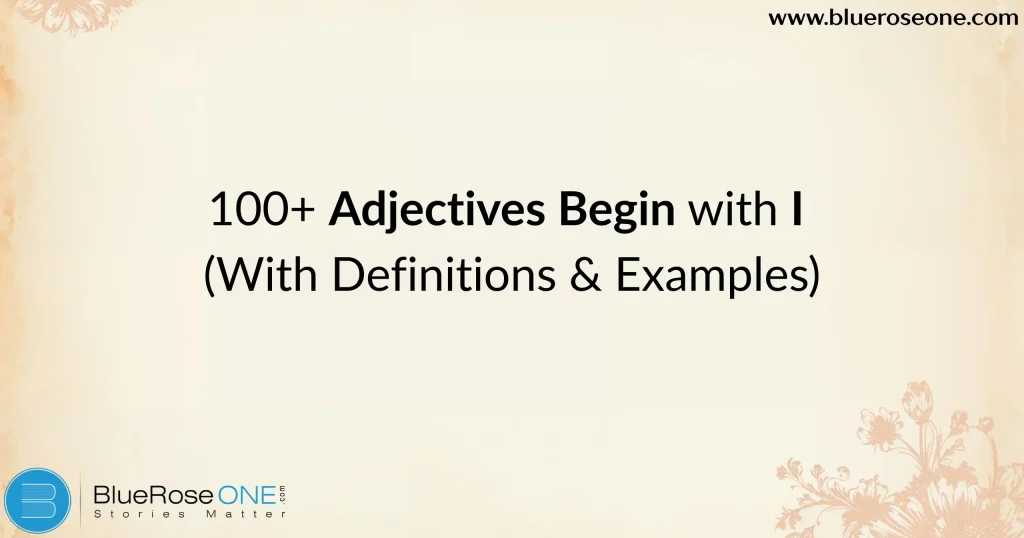
100+ Adjectives Begin with I (With Definitions & Examples)
Table of Content What Are Adjectives? Adjectives are like the seasoning of language; they give nouns their flavor. They help describe people, places, things, or ideas by answering questions like what kind?, which one?, or how many? Why “I” Adjectives Matter in Language You might not think the letter “I” holds much power, but you’d be surprised. “I” adjectives can make your language sound insightful, intense, or even imaginative. Whether you’re a writer, student, or just trying to expand your vocabulary, this list has got you covered. You may also like: 100+ Adjectives That Start with C (With Definitions & Examples) Positive Adjectives Begin with I Inspiring Adjectives These adjectives can uplift, motivate, and leave a good impression. Personality-Boosting Adjectives Negative Adjectives Bgein with I Describing Negative Traits You may also like: Top 100 Words Starts with V to Improve Your English Writing and Speaking Common in Conflict and Critique Descriptive Adjectives for People Some “I” adjectives are tailor-made to describe personalities, traits, or behaviors. Use these to add color to character descriptions in stories, bios, or resumes. You may also like: 150+ Positive Words That Start with O to Brighten Your Vocabulary Descriptive Adjectives for Things or Ideas Whether you’re talking about a concept or a coffee mug, “I” adjectives help! Emotional & Mental State Adjectives These relate to inner thoughts and feelings. Appearance & Physical Traits Adjectives Perfect for describing looks, settings, or moods. You may also like: 100+ Adjectives Begin with N (With Meanings & Examples) Action-Oriented or Dynamic Adjectives Use these for energy, motion, or transformation. Rare & Unusual “I” Adjectives Get ready to impress! You won’t find these in casual conversation, but they sparkle in essays or literature. Academic & Formal “I” Adjectives Great for scholarly or formal writing. Slang and Informal “I” Adjectives These bring flavor to casual speech. Adjectives for Writing & Storytelling Create vivid imagery and emotional depth. More Adjectives Begin with I Adjective Definition Example Sentence Idealistic Guided by ideals She has an idealistic view of the world. Icy Cold or unfriendly His tone was icy during the call. Immaculate Spotlessly clean The room was immaculate. Impeccable Flawless Her manners were impeccable. Incredible Hard to believe He told an incredible story. Indelible Cannot be erased That memory was indelible. Inaccurate Not correct Your data seems inaccurate. Indecisive Not able to decide He’s very indecisive under pressure. Infectious Spread easily Her laughter was infectious. Industrious Hardworking She’s an industrious student. Inexplicable Unexplainable The event was inexplicable. Conclusion So there you have it—over 100 adjectives starting with “I” that can supercharge your vocabulary and writing. From emotional depth to physical descriptions, from formal to funny, these adjectives help you say exactly what you mean, with impact. Frequently Asked Questions
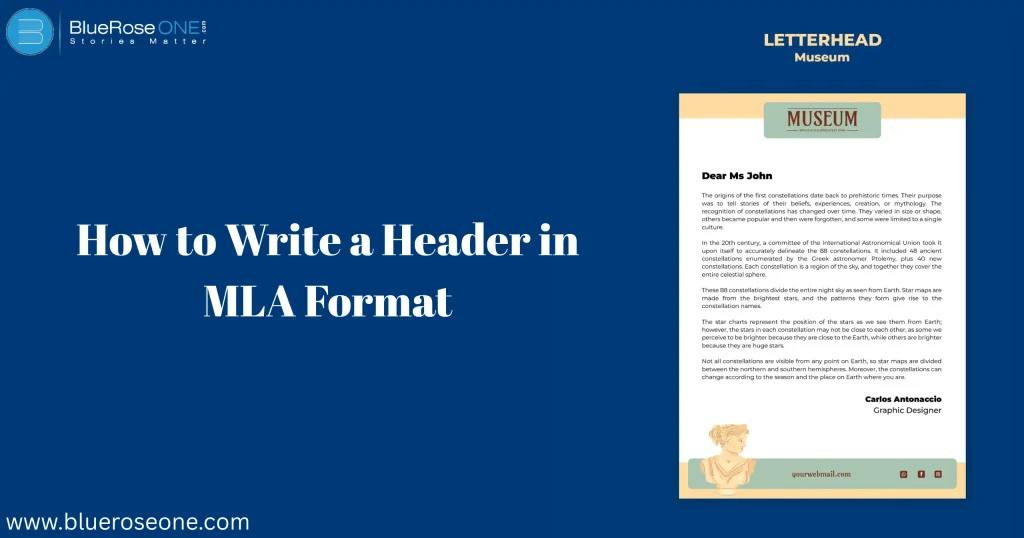
How to Write a Header in MLA Format | A Step-by-Step Guide
When writing an academic paper, adhering to proper formatting styles is crucial. The Modern Language Association (MLA) style is widely used in the humanities, especially in English literature, cultural studies, and related fields. One of the most basic yet important formatting elements in MLA is the header. A correct MLA header ensures your work is organized, professional, and meets academic standards. This comprehensive guide will walk you step-by-step through how to write a header in MLA format, covering both the first-page header and the running head that appears on every page. Whether you’re a high school student, college undergraduate, or even a seasoned academic, this guide will simplify the process for you. You may also like: 100+ Adjectives That Start with C (With Definitions & Examples) What is MLA Format? Before diving into headers specifically, it’s important to understand what MLA format entails. Created by the Modern Language Association, this style provides a consistent format for writing papers and citing sources in the humanities. Basic Elements of MLA Format: Double-spacing throughout the paper 1-inch margins on all sides A readable font like Times New Roman, size 12 Indented first lines for each paragraph A header on the first page (with student information) A running head (with the author’s last name and page number) A Works Cited page for references Now, let’s break down the header components in MLA style. Part 1: Writing the First-Page Header The first-page header in MLA format includes your name, instructor’s name, course name or number, and the date. This information is aligned to the left-hand side at the top of the first page. Step-by-Step Guide: 1. Open a New Document Open your preferred word processor (Microsoft Word, Google Docs, etc.). Set the font to Times New Roman, 12-point size. Set the margins to 1 inch on all sides. 2. Add Student Information (Left-Aligned) At the top-left corner of the first page, include the following, double-spaced: Your Full NameInstructor’s NameCourse Name or NumberDate (in Day Month Year format) Example: Alex JohnsonProfessor SmithEnglish 1018 July 2025 3. Center the Title After entering the student information, press Enter once and center the title of your paper. Do not bold, underline, italicize, or use all caps. Use standard capitalization (title case). Example: The Role of Symbolism in Shakespeare’s Macbeth Part 2: Inserting the Running Head (Top Right Corner) The running head includes your last name followed by the page number, and it appears in the top-right corner of every page, including the first. Why Is the Running Head Important? It helps identify the author of the paper and ensures that pages stay organized, especially when printed or reviewed in bulk. Step-by-Step Instructions by Platform: In Microsoft Word: Go to Insert > Header. Select the option that aligns text to the right. Type your last name, press the spacebar, then click Insert > Page Number > Current Position > Plain Number. Close the header section. In Google Docs: Go to Insert > Headers & footers > Header. Press the Tab key to move the cursor to the right. Type your last name, add a space, then click Insert > Page numbers > Top of page. Result: Johnson 1 Make sure the font and size of the header match the rest of the document. Part 3: Common Mistakes to Avoid To ensure your MLA header is correctly formatted, steer clear of these frequent errors: 1. Using a Different Date Format MLA requires the date format to be Day Month Year, not numerical (e.g., 08/07/25). 2. Incorrect Alignment Student information should be left-aligned. The title should be centered. The running head should be right-aligned. 3. Applying Header to Only the First Page The running head should appear on every page, not just the first. 4. Formatting Inconsistencies Make sure the font, spacing, and margins remain consistent throughout. You may also like: Common Poetic Devices with Examples & Types Part 4: Sample MLA First Page Here’s an example layout of what your first page should look like in MLA format: Alex JohnsonProfessor SmithEnglish 1018 July 2025 The Role of Symbolism in Shakespeare’s Macbeth William Shakespeare’s use of symbolism in Macbeth reveals deep themes of ambition, guilt, and fate. The recurring motifs of blood, darkness… And at the top-right corner: Johnson 1 Part 5: MLA Header for Group Projects If you’re working on a group project, you can modify the first-page header slightly. Group Header Format: List each group member’s name on a separate line Follow with the instructor’s name, course, and date. Examples: Alex JohnsonMaria LopezEthan KimProfessor SmithHistory 2028 July 2025 The rest of the format remains the same. You may also like: 150 Useful Tone Words to Describe Tone | Explanation with Examples Part 6: Final Checklist for Your MLA Header Before submitting your paper, make sure your MLA header follows all formatting requirements. Begin by ensuring that your full name, instructor’s name, course name, and date (written in the Day Month Year format) are accurately listed in the upper left corner of the first page. Make sure the text is double-spaced and has a readable typeface, such as Times New Roman, size 12. Make sure the header with your last name and page number is right-aligned in the upper right corner and displays on each page. Make sure the text is bolded and free of additional spaces. Lastly, after exporting or converting your work to PDF, preview it to make sure the formatting is maintained. This easy checklist guarantees that your work looks polished and professional and helps you avoid losing points for formatting mistakes. You may also read: Where the Red Fern Grows Book Summary & Themes Part 7: Why MLA Header Format Matters Using the correct MLA header does more than just meet academic standards. It demonstrates professionalism, attention to detail, and respect for scholarly standards. A well-formatted document creates a favorable first impression on teachers and readers, increasing readability and credibility. Furthermore, consistency in format guarantees that your work is consistent with that of thousands of others in the academic world,…
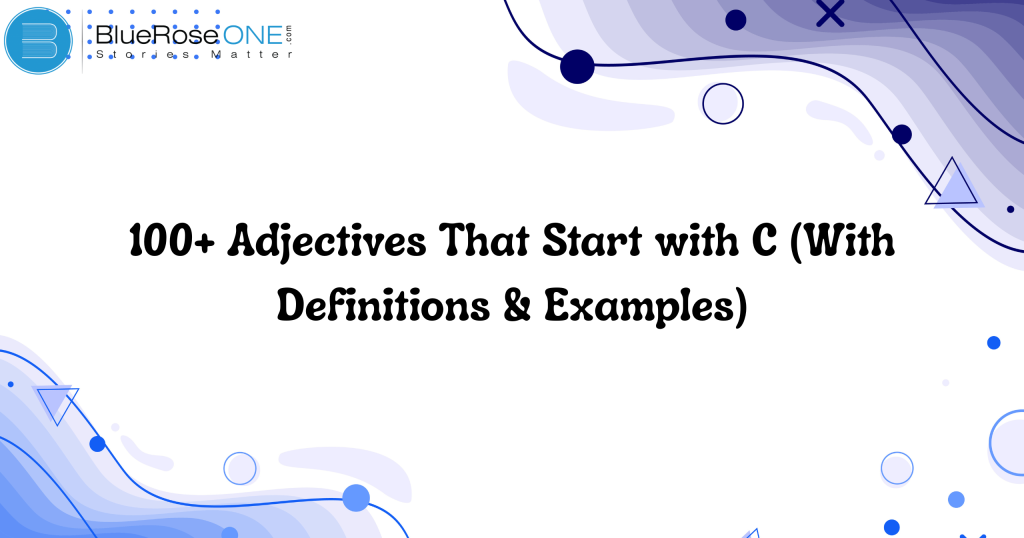
100+ Adjectives That Start with C (With Definitions & Examples)
Ever been stuck trying to find the perfect word? Adjectives are your best friends they add color, depth, and emotion to otherwise flat sentences. Today, we’re diving into adjectives that begin with the letter C—a letter that packs a powerful punch with words like “charming,” “cruel,” and “curious.” Whether you’re a writer, student, or language enthusiast, this list will level up your vocabulary game. What Are Adjectives? Adjectives are words that describe, modify, or quantify nouns and pronouns, helping to provide more detail and specificity in language. They answer questions such as what kind?, how many?, which one?, or whose?. For example, in the phrase “blue sky,” the word “blue” is an adjective describing the noun “sky.” Adjectives can appear before the noun (attributive position) or after linking verbs (predicative position), as in “The sky is blue.” They play a crucial role in communication by enriching sentences, clarifying meaning, and adding emotional or descriptive depth. Adjectives vary in type, including descriptive (e.g., “beautiful”), quantitative (“many”), demonstrative (“this”), possessive (“her”), and interrogative (“which”), among others. You may also read: Common Poetic Devices with Examples & Types Role of Adjectives in Sentences They help answer questions like: What kind? → A clever idea How many? → Several chances Which one? → That cute puppy Types of Adjectives Descriptive (e.g., courageous, cold) Quantitative (e.g., countless, couple) Demonstrative (e.g., certain, chosen) Possessive (e.g., child’s, cousin’s) Interrogative (e.g., which, whose) Descriptive Adjectives That Start with C Positive Descriptive Adjectives Charming – Delightfully pleasing. Example: She gave a charming smile. Creative – Full of imagination. Example: He’s a creative designer. Negative Descriptive Adjectives Cruel – Willfully causing pain Example: That was a cruel joke. Chaotic – Utterly disorganized Example: The room was chaotic after the party. You may also like: Top 100 Words Starts with V to Improve Your English Writing and Speaking Personality Adjectives That Start with C Character Traits Courageous – Showing bravery. Example: The firefighter was courageous. Cunning – Skilled in deception Example: The fox is a cunning animal. Emotional States Cheerful – Happy and optimistic. Example: Her cheerful attitude lifted the room. Cranky – Easily irritated Example: The baby was cranky after the nap. Adjectives That Start with C to Describe Appearance People Chiseled – Having strong, sharp facial features. Example: He had a chiseled jawline. Curvaceous – Having shapely curves. Example: She wore a dress that flattered her curvaceous figure. Objects Cracked – Broken without being divided Example: The cracked vase still held water. Clean – Free from dirt. Example: The kitchen was sparkling clean. You may also like: 100+ Adjectives Begin with N (With Meanings & Examples) Adjectives That Start with C to Describe Feelings Emotions & Moods Comforted – Feeling relief. Example: I felt comforted by her words. Confused – Unable to think clearly Example: He looked confused after the announcement. Common Adjectives That Start with C in Literature Examples in Writing Authors often use C adjectives for vivid imagery: “The cold wind sliced through the canyon.” “Her calm demeanor under pressure was admirable.” Impact on Tone and Style Whether you’re going for cheerful or chilling, choosing the right C-word can set the perfect tone in your writing. You may also like: Where the Red Fern Grows Book Summary & Themes You may also like: 20 Satire Examples in Real-World Every Writer Should Know 100+ Adjectives That Start with C Adjective Definition Example Sentence Calm Peaceful and quiet She stayed calm during the storm. Capable Having ability or skill He is a capable leader. Careful Showing caution Be careful while driving. Caring Showing concern She’s a very caring friend. Casual Relaxed and informal He wore casual clothes to the party. Catchy Easy to remember That song is so catchy! Cautious Careful to avoid danger He’s cautious around new people. Celebrated Famous and praised A celebrated author was at the event. Cerebral Intellectual The book was quite cerebral. Chilly Uncomfortably cold It’s a bit chilly today. Clumsy Awkward and uncoordinated I’m too clumsy for ballet. Clever Smart and witty That was a clever trick. Cloudy Overcast with clouds It’s cloudy outside. Coarse Rough in texture The fabric felt coarse. Cold Lacking warmth His tone was cold and indifferent. Colorful Full of color She wore a colorful dress. Comedic Funny The movie had a comedic tone. Comfortable Giving ease This chair is super comfortable. Complicated Hard to understand That math problem is complicated. Concise Brief and clear Her speech was concise. Confident Self-assured She is confident in her skills. Confusing Hard to understand The instructions were confusing. Conscious Aware and alert He remained conscious after the fall. Conservative Traditional or cautious He has conservative views. Considerate Thoughtful of others She’s very considerate toward the elderly. Consistent Steady and reliable His performance is consistent. Contagious Easily spread Laughter can be contagious. Content Satisfied I feel content with my life. Cooperative Willing to help The team was very cooperative. Courageous Brave The knight was courageous. Creative Imaginative She’s a creative thinker. Creepy Causing fear That place looks creepy. Crisp Fresh and cool The air was crisp this morning. Critical Disapproving or essential He gave a critical review. Crooked Not straight The picture frame is crooked. Cruel Intentionally harmful That was a cruel thing to do. Curious Eager to learn Kids are naturally curious. Cursed Under a spell or misfortune The island was believed to be cursed. Customary According to custom It’s customary to tip the waiter. How to Use These Adjectives Effectively Tips for Writers Use them to enhance imagery. Choose adjectives that match the tone of your content. Avoid overuse—moderation matters. Tips for Students & ESL Learners Create flashcards. Use adjectives in your daily journal. Practice with sentence building exercises. Final Thoughts Adjectives that start with the letter C are both charming and crucial to expressive communication. From everyday conversation to literary storytelling, these words help us add nuance, emotion, and clarity. Keep this list handy as your vocabulary companion. It’ll serve you well whether you’re writing an essay, a poem, or even just a clever…
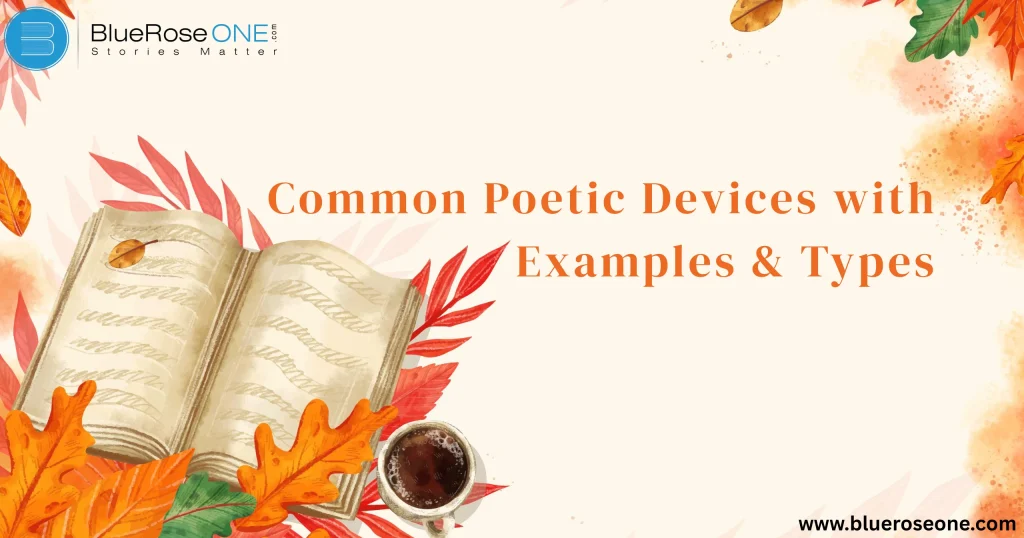
Common Poetic Devices with Examples & Types
Ever read a poem and thought, “Wow, that line just hits differently”? That magical punch often comes from poetic devices those clever tools poets use to stir your soul, paint vivid images, or make their words sing. Whether you’re a student, writer, or poetry lover, understanding these devices can help you see beyond the surface and truly feel the poem. Let’s break down the most common poetic devices with examples and types so you can identify and appreciate them with ease. Major Types of Poetic Devices Sound-Based Devices These devices focus on the musical quality of poetry. They’re what make a poem memorable, rhythmical, and pleasing to the ear. Alliteration Alliteration is a poetic device that involves the repetition of initial consonant sounds in closely positioned words, often used to create rhythm, mood, or emphasis. It is commonly found in poetry, tongue twisters, and even brand names. For example, in the line “She sells seashells by the seashore,” the repeated “s” sound enhances the musicality and flow of the phrase. Alliteration draws attention to specific words or themes, making the language more memorable and engaging for readers. Example: “Peter Piper picked a peck of pickled peppers.” Why It Works: It creates a musical effect and draws attention to specific lines or emotions. You may also like: Where the Red Fern Grows: Book Summary & Themes Assonance Assonance is a poetic device that uses the repeating of vowel sounds inside adjacent words to produce internal rhyme and musicality. It frequently improves the mood or rhythm of a line, making it more engaging or emotionally meaningful. Unlike rhyme, assonance focuses primarily on vowel sounds rather than full syllables. For example, Edgar Allan Poe’s phrase “Hear the mellow wedding bells” uses a repeated “e” sound to produce a smooth, harmonic tone that suits the images. Example: “The early bird catches the worm.” Why It Works: It builds internal rhyming and enhances the mood or flow. Consonance Consonance is a poetic device characterized by the repetition of consonant sounds within or at the end of words in close proximity. Unlike alliteration, which emphasizes initial consonant sounds, consonance focuses on recurring sounds regardless of position. This technique adds rhythm, musicality, and emphasis to poetry. For example, in the phrase “pitter-patter”, the repeated t and r sounds create a pleasing auditory effect. Poets use consonance to unify lines and enhance the mood or tone of a poem. Example: “Pitter-patter, the rain made a clatter.” Why It Works: It reinforces rhythm and unites lines through sound. You may also like: Top 100 Words Starts with V to Improve Your English Writing and Speaking Onomatopoeia Onomatopoeia is a poetic device in which a word imitates the natural sound it represents, so improving the sensory experience of the poem. Buzz, clang, whisper, and sizzle are some common examples. Poets utilize onomatopoeia to generate vivid imagery and immerse readers into the situation using sound. For example, in Alfred Lord Tennyson’s “Come Down, O Maid,” the word murmur evokes the soothing sound of a brook, making the poem more immersive and emotionally resonant. Example: “Buzz,” “crash,” “sizzle,” “bang.” Why It Works: Brings the scene alive with auditory imagery. Rhyme & Internal Rhyme Rhyme is the recurrence of similar-sounding words at the conclusion of lines in poetry, resulting in a melodic or lyrical aspect. Internal rhyming, however, occurs within a single line rather than at line breaks. Both improve the poem’s rhythm and memorability. For example, the phrase “Once upon a midnight dreary, while I pondered, weak and weary” in Edgar Allan Poe’s “The Raven” demonstrates the internal rhyme between “dreary” and “weary.” These devices increase engagement and emphasize thematic components. Example: “Once upon a midnight dreary, while I pondered, weak and weary…” – Edgar Allan Poe Why It Works: Rhyme enhances memorability and structure. You may also like: 10 Classic Flat Character Examples in Literature and Film Repetition Repetition is a powerful poetic device used to emphasize a feeling, create rhythm, or reinforce a theme by repeating words, phrases, or lines. Poets often use repetition to make their verses more memorable and emotionally impactful. For example, in Edgar Allan Poe’s “The Bells,” the repeated use of the word “bells” mirrors the clanging sound and builds a musical quality. Repetition can appear in various forms such as anaphora, epiphora, or refrain, depending on its placement in a poem. Example: “And miles to go before I sleep, And miles to go before I sleep.” – Robert Frost Why It Works: It creates rhythm, emphasis, and emotional power. Meaning-Based Poetic Devices These focus on figurative language and deeper interpretation. Metaphor Metaphor is a fundamental poetic device that compares two unrelated things by stating one is the other, without using “like” or “as.” It deepens meaning and evokes vivid imagery. For example, in Shakespeare’s “All the world’s a stage,” the world is metaphorically compared to a stage, highlighting the roles people play in life. Metaphors help poets express abstract ideas more tangibly, enhancing emotional impact and enabling readers to connect with deeper symbolic layers of meaning. Example: “Time is a thief.” Why It Works: It reveals deeper meanings and abstract connections. You may also like: Negative Adjectives to Describe People: Examples and Meanings Simile A simile is a poetic device that directly contrasts two unlike things, utilizing the words “like” or “as” to produce vivid pictures and enhance meaning. It helps readers visualize concepts by connecting new ones to familiar ones. For example, in the expression “as brave as a lion,” courage is compared to the strength of a lion. Similes are commonly employed in poetry and prose to increase emotional impact and produce vivid, unforgettable descriptions in a few lines. Example: “She was as brave as a lion.” Why It Works: Similes clarify and strengthen imagery. Symbolism Symbolism is a powerful poetic device where objects, characters, or actions represent deeper meanings beyond their literal sense. Poets employ symbolism to subtly and multi-layeredly express difficult feelings, thoughts, and concepts. For instance, the diverging roads represent life choices in…
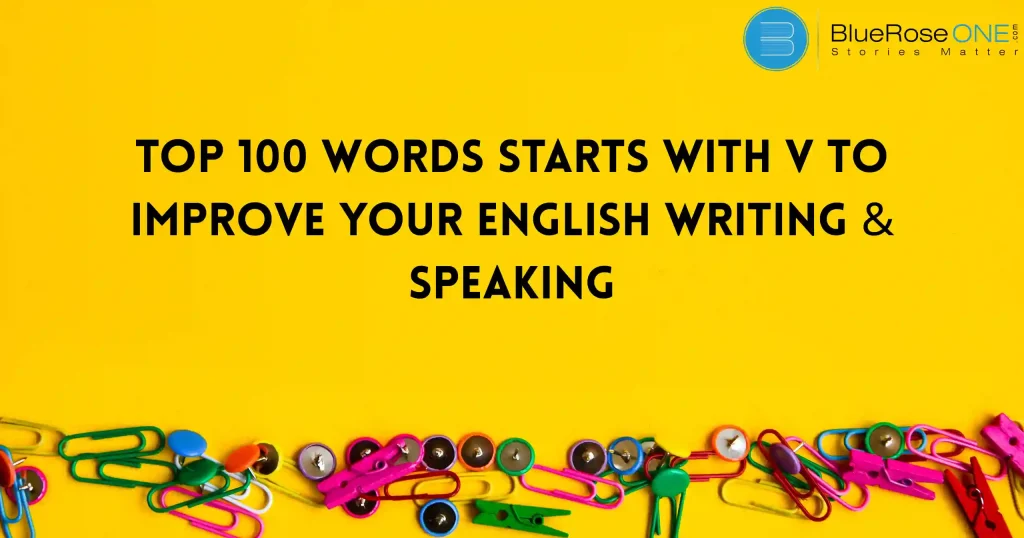
Top 100 Words Starts with V to Improve Your English Writing and Speaking
Ever felt like your vocabulary was holding you back from expressing yourself better? You’re not alone. A strong vocabulary is like a toolbox. You need the right tools for the right situation. And guess what? The letter “V” packs some seriously powerful tools. From vibrant verbs to vivid adjectives, V words can supercharge your speaking and writing skills. So, let’s dive into the vault of V words and unlock your linguistic potential. Action-Oriented V Words Common Verbs That Start with V These are everyday verbs that you’ll hear often and can use confidently: Visit Vote Venture View Vary Vanish Verify Advanced Verbs with “V” for Impact Want to level up your writing? Try these sophisticated verbs: Vindicate (to clear of blame) Vilify (to speak ill of) Vacillate (to waver between decisions) Venerate (to honor deeply) Veer (to change direction suddenly) You may also read: Where the Red Fern Grows: Book Summary & Themes Using Action “V” Words in Real-Life Sentences “She vindicated herself by presenting undeniable proof.” “He ventured into uncharted territory despite warnings.” “The politician vowed to bring change.” Descriptive V Words for Writing V Adjectives That Add Color Vibrant Vicious Vast Vocal Volatile Valiant Vintage Using V Words to Strengthen Narratives Great writers show, not tell. Using V adjectives creates more vivid mental images. “The vicious storm tore through the town.” “Her valiant effort earned her a medal.” Example Sentences with V Adjectives “He wore a vintage jacket from the 80s.” “The vbrant hues of the painting drew everyone’s attention.” You may also like: 10 Classic Flat Character Examples in Literature and Film V Words to Elevate Your Speaking Skills Impressive V Words for Conversations Want to sound more polished and articulate? Versatile Vivid Valid Viable Virtuous Vocabulary for Public Speaking & Presentations Words that add authority and style: Viability Visionary Verdict Venue Venture How to Naturally Insert V Words in Dialogue Instead of: “I think it’s possible.” Say: “I believe it’s a viable option.” Academic and Professional V Words V Words for Essays and Reports Validate Variable Volume Violation Verification You may also like: Negative Adjectives to Describe People: Examples and Meanings Formal V Words Used in Business English Venture Valuation Vendor Vested Viability Tips on Using Sophisticated V Words Without Overdoing It Use contextually relevant words. Avoid fluff; each word should add value. Don’t force rare words if simpler ones work better. You may also like: 150+ Positive Words That Start with O to Brighten Your Vocabulary Positive V Words for Motivation and Mindset Inspirational V Words Victory Vision Vitality Value Virtue Character-Boosting V Words Vigorous Valiant Versed Vibrant Visionary Daily Affirmations with V Words “I am a visionary building my future.” “I bring vitality and joy to everything I do.” “My values guide my success.” Fun and Quirky V Words to Spice Up Language Rare and Unusual V Words Verbose (wordy) Vatic (prophetic) Vulpine (fox-like) Verisimilitude (appearance of truth) Vaticinate (to foretell) Words That Make You Sound Smarter Veracity Vicissitude Vanguard Vociferous Vitriolic Etymology Fun Facts of Selected V Words “Vulpine” comes from Latin vulpes, meaning fox. “Vatic” has roots in ancient Latin prophecy traditions. You may also like: Archangels Names List: Meanings, Powers, and Symbolism Top 100 V Words List (Categorized) V Verbs Vanish Validate Vow Volunteer Venture Verify Visit Value View Vex V Adjectives Valiant Volatile Vintage Vibrant Vain Vocal Verdant Vast Vicious Virile V Nouns Victory Vision Venture Vendor Vortex Vigil Verdict Virtue Viability Value You may also like: 400 Adjectives That Start with L to Level Up Your Vocabulary How to Memorize and Practice V Words Techniques for Better Retention Mnemonics Word Associations Repetition Flashcard and App Recommendations Anki Quizlet Vocabulary.com Games and Quizzes for Practice Wordle with “V” Themes Crossword Puzzles V Word Bingo Conclusion Boosting your vocabulary doesn’t have to be boring and when it comes to the letter “V”, you’re getting a vault of value-packed words! Whether you’re a student, speaker, or writer. These vibrant V words can make your expression more vivid, your communication more valid, and your thoughts more valuable. Dive in, practice daily, and soon enough, you’ll be the virtuoso of vocabulary. Frequently asked questions 1. What is a powerful verb starting with V? Vindicate is a powerful verb that means to clear someone from blame or suspicion. 2. How can I remember difficult V words? Use flashcards, make fun sentences, or associate the word with images or personal experiences. 3. Are V words useful in everyday conversations? Absolutely! Words like visit, vote, value, and venture are used daily. 4. What’s a good V word for essays? Validate is an excellent word often used in academic writing to support arguments or claims.Content 5. How can I teach V words to children? Use games, storytelling, and visuals to make learning engaging and memorable.
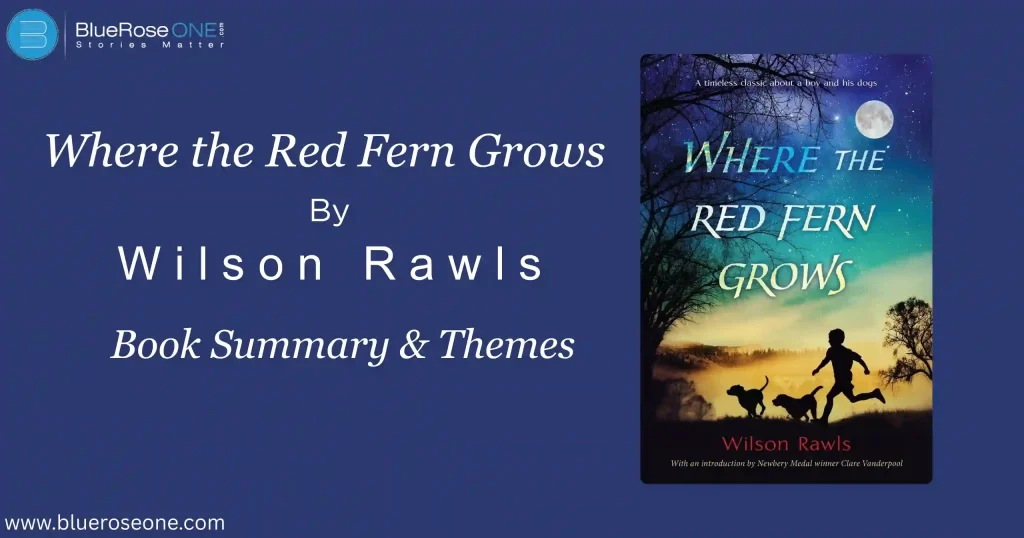
Where the Red Fern Grows Book Summary & Themes
Table of Content Overview of the Novel Where the Red Fern Grows is a touching coming-of-age novel written by Wilson Rawls, first published in 1961. It follows a young boy named Billy and his deep bond with his two Redbone Coonhounds, Old Dan and Little Ann. Set in the Ozark Mountains during the Great Depression, the story captures the innocence of youth, the strength of dreams, and the heartbreak of loss. About the Author – Wilson Rawls Wilson Rawls grew up in Oklahoma, much like his protagonist Billy. His love for the outdoors and storytelling was influenced by his own rural upbringing. Interestingly, Rawls burned his original manuscript out of embarrassment, only to rewrite it later thanks to encouragement from his wife. That second chance gave the world one of its most enduring children’s novels. Why This Book Still Resonates Today Despite being over six decades old, the story remains a favorite in classrooms and libraries. Its timeless values of perseverance, family, and love continue to speak to readers of all ages. Detailed Book Summary Setting of the Story The setting of Where the Red Fern Grows plays a powerful role in shaping the story’s tone and emotional depth. Set in the Ozark Mountains during the Great Depression, the rural landscape is both beautiful and harsh mirroring the challenges young Billy faces. The forests, rivers, and open fields aren’t just backdrops; they become part of his journey, teaching him resilience, responsibility, and love. This natural, isolated world allows readers to fully immerse themselves in Billy’s bond with his dogs and his coming-of-age experiences. Main Characters – Where the Red Fern Grows Plot Breakdown Billy’s Dream of Owning Hunting Dogs Billy’s dream of owning hunting dogs lies at the heart of Where the Red Fern Grows. From the moment he first sees a coonhound in a magazine, he becomes consumed by the desire to have his own. Despite his family’s poverty, Billy works tirelessly for two years, saving every penny he can. His determination and sacrifice reveal the depth of his passion. This dream not only drives the story forward but also highlights Billy’s resilience, grit, and the innocence of childhood ambition. The Journey to Get His Dogs One of the most heartfelt moments in Where the Red Fern Grows is Billy’s determined journey to get his beloved hounds. After saving every penny for two years, young Billy finally has enough money to buy the coonhound pups he’s long dreamed of. But the process isn’t easy. He learns the dogs are in Tahlequah, Oklahoma miles away from his home in the Ozarks. Driven by sheer will and love, Billy walks the entire way barefoot, braving the wilderness alone, to pick up the pups. His journey isn’t just about getting dogs it’s about proving his maturity, commitment, and deep sense of purpose. Along the way, he experiences kindness from strangers, confronts challenges, and gains a glimpse of the wider world beyond his mountain home. When he finally brings the pups back home in a sack, his bond with them is already sealed. This part of the story resonates deeply with readers because it reflects a pure kind of determination and love that makes us root for Billy from the very start of his unforgettable journey. You may also like: 10 Classic Flat Character Examples in Literature and Film Adventures in the Ozarks The heart of Where the Red Fern Grows is the fascinating exploits that take place in the Ozark Mountains. As little Billy and his two loyal Redbone Coonhounds, Old Dan and Little Ann, venture into the wilderness, readers are transported into a world of moonlit hunts, difficult terrain, and profound emotional connections. These exploits are about more than just chasing raccoons; they are about grit, growth, and the strength of a boy’s bond with his dogs. The colorful setting of the Ozarks adds both beauty and danger, making every hunt feel like a test of fortitude and every win a personally personal one. The Championship Coon Hunt In Where the Red Fern Grows, “The Championship Coon Hunt” is an exciting and emotional highlight. Billy and his loyal dogs, Old Dan and Little Ann, compete in a coon-hunting competition that tests their ability, determination, and friendship. Despite the tough weather and intense competition, the trio’s teamwork shines. Little Ann’s knowledge and Old Dan’s strength propel them to success, earning the admiration of seasoned hunters. This moment is about more than just victory; it is also about a boy’s strong trust in his dogs. The hunt exemplifies strength, tenacity, and love, making it one of the most memorable portions of the novel. Tragic Ending The heartbreaking finale of Where the Red Fern Grows has a lasting impact on readers. After a fierce encounter with a mountain lion, Old Dan dies of his injuries, and Little Ann, overcome with grief, dies near his grave. This devastating loss serves as the story’s dramatic finale, highlighting the boy’s strong attachment with his pets. Their deaths are more than just sad; they represent love, devotion, and the anguish of growing up. However, the red fern that blooms between their graves provides readers with a sense of serenity and spiritual closure, telling them that love survives even after death. You may also read: Negative Adjectives to Describe People: Examples and Meanings In-Depth Look at the Main Characters Billy Colman – The Heart of the Story Billy Colman is the emotional center of Where the Red Fern Grows. Billy, a small kid with an indomitable resolve, is determined to buy his two hunting dogs, Old Dan and Little Ann, demonstrating a deep sense of purpose and maturity well above his age. His relationship with the hounds is more than just hunting; it is a narrative of devotion, love, and maturing. Billy’s journey, which includes both victories and heartbreaks, represents the innocence and intensity of boyhood dreams. Readers identify with Billy because he reminds them of the tremendous feelings associated with their first ambitions, first defeats, and the…
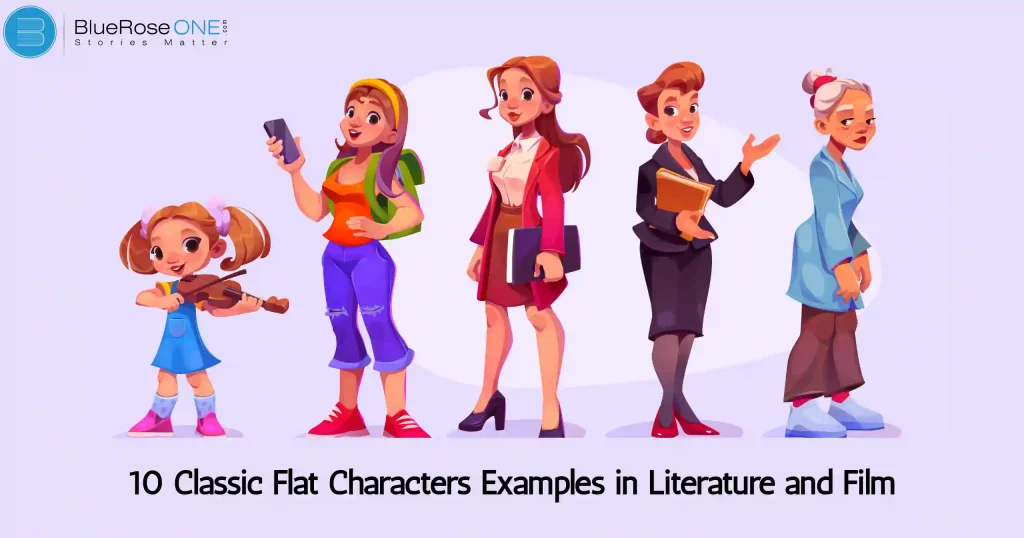
10 Classic Flat Character Examples in Literature and Film
Ever noticed how some characters in stories seem to have one job and do it well, no growth, no big twists, just there being their consistent, predictable selves? That’s a flat character for you. While they might not be the stars of the show, they hold the story together in surprising ways. In this article, we’re diving deep into the world of flat characters, flat character examples and breaking down 10 classic examples from both literature and film. Buckle up, it’s more fascinating than you might think! Table of Content Definition of Flat Characters Flat characters are the simple ones. They’re defined by one or two key traits and don’t really change throughout the story. They’re consistent, predictable, and often serve a very specific purpose. Think of them as the “what you see is what you get” people in a story. Traits of a Flat Character The Role of Flat Characters in Literature and Film Supporting the Protagonist Flat characters are frequently used as powerful tools to highlight and encourage the protagonist’s development. Their consistency contrasts with the hero’s complexity. These characters do not evolve, but instead serve as emotional anchors or moral compasses. They have consistent views or attitudes, allowing the protagonist’s metamorphosis to show. For example, in many classic stories, a faithful buddy or sidekick exists exclusively to aid the hero’s journey. Their presence highlights the protagonist’s inner conflicts without diverting attention. Flat characters reinforce themes and provide narrative consistency. Representing a Single Idea or Trait Flat characters are often designed to represent a single dominant idea or trait, serving as clear symbols within a story. Whether it’s loyalty, greed, innocence, or cruelty, these characters embody their defining quality without undergoing internal change. Their simplicity makes them effective tools for highlighting central themes or contrasting more complex characters. In both literature and film, flat characters help clarify the narrative by staying true to their role, making them memorable and essential despite their limited emotional or psychological depth. Providing Contrast or Consistency Flat characters play a vital role in providing contrast or consistency within a story. Their limited development allows them to act as steady reference points against which dynamic characters evolve. For instance, their unchanging traits can highlight the growth, flaws, or transformation of the protagonist. In contrast, flat characters may also reinforce a story’s theme or mood through their predictable behavior. Whether as comic relief, loyal sidekicks, or moral compasses, they bring clarity and balance to complex narratives without overshadowing the main plot. You may also like: 20 Satire Examples in Real-World Every Writer Should Know 10 Classic Flat Character Examples 1. Mr. Collins – Pride and Prejudice Mr. Collins from Pride and Prejudice is a prime example of a flat character. Throughout the novel, he remains pompous, obsequious, and blindly devoted to Lady Catherine de Bourgh. His exaggerated manners and lack of personal growth serve as comic relief and highlight the social satire central to Jane Austen’s narrative. 2. Mercutio – Romeo and Juliet Mercutio, Romeo’s witty and provocative friend in Shakespeare’s Romeo and Juliet, is a classic flat character. He remains bold, sarcastic, and cynical throughout the play. His consistent traits provide comic relief and contrast Romeo’s romanticism, but Mercutio’s unwavering demeanor also sets the stage for the tragic turn in the story. 3. Miss Trunchbull – Matilda Miss Trunchbull from Matilda is a classic flat character, embodying tyranny and cruelty without much emotional depth or change. As the authoritarian headmistress, she serves as a clear antagonist, reinforcing the story’s conflict. Her exaggerated villainy highlights Matilda’s courage and resilience, making her a memorable and effective literary foil. 4. Crabbe and Goyle – Harry Potter Crabbe and Goyle from Harry Potter serve as classic flat characters, consistently portrayed as Draco Malfoy’s dull-witted, loyal henchmen. Their limited development and repetitive behavior bullying others and blindly following Draco highlight their narrative role as static antagonists. They provide comic relief and contrast to the more dynamic main characters. 5. Bruce the Shark – Finding Nemo Bruce, the great white shark in Finding Nemo, serves as a classic flat character. His personality is defined by a single comedic trait: his struggle to resist eating fish, summed up by his motto, “Fish are friends, not food.” Bruce’s character doesn’t evolve, maintaining his humorous contradiction throughout the film. 6. The Wicked Witch of the West – The Wizard of Oz The Wicked Witch of the West from The Wizard of Oz is a prime flat character, driven solely by revenge and cruelty. She lacks depth or transformation, serving as a constant antagonist. Her unwavering evil highlights Dorothy’s goodness, making her a classic example of a one-dimensional villain in literature and film. 7. Scar – The Lion King Scar from The Lion King is a classic flat character driven by jealousy and ambition. His personality remains consistent, manipulative, cunning, and power-hungry throughout the film. Scar’s lack of character growth reinforces his role as a villain, making him a clear, unchanging antagonist in contrast to Simba’s evolving hero journey. 8. Javert – Les Misérables Javert from Les Misérables is a classic flat character defined by his unwavering commitment to law and order. Throughout the novel, he relentlessly pursues justice, unable to reconcile his rigid beliefs with moral complexity. His lack of character evolution highlights the dangers of blind adherence to authority and rules. 9. Frankenstein’s Monster – Frankenstein Frankenstein’s Monster in Mary Shelley’s Frankenstein is another classic flat character, primarily defined by his tragic isolation and yearning for acceptance. Though he evolves emotionally, he remains largely consistent in his sorrow and rejection. His role highlights society’s fear of the unknown, reinforcing the novel’s central themes of alienation and identity. 10. Bellatrix Lestrange – Harry Potter Bellatrix Lestrange is a quintessential flat character in the Harry Potter series, defined by her unwavering loyalty to Voldemort and unrelenting cruelty. She remains consistently sadistic and obsessed with dark magic, showing no moral growth or complexity. Her single-minded devotion makes her a powerful, yet one-dimensional antagonist throughout…
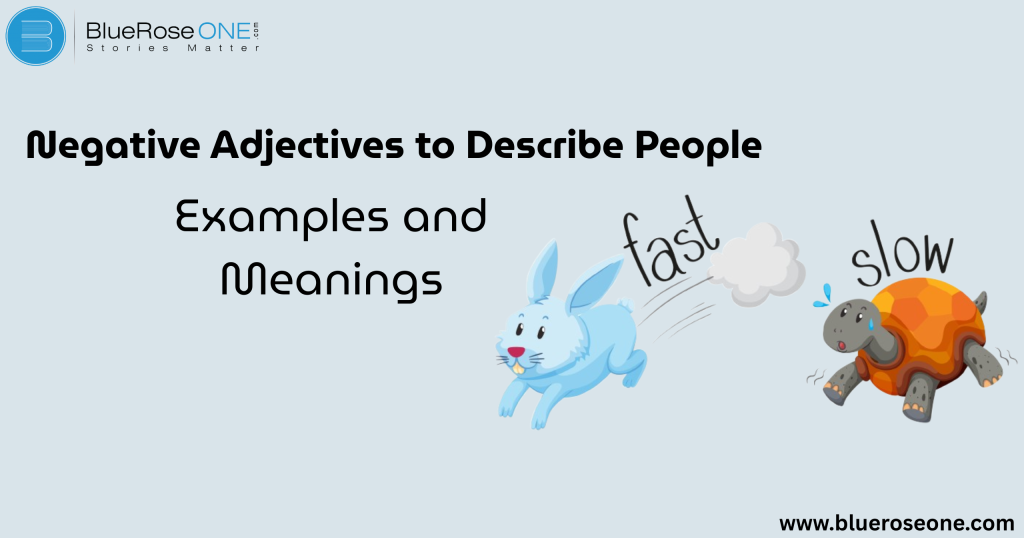
Negative Adjectives to Describe People: Examples and Meanings
Words matter, especially when they describe people. We’ve all been called something that stung maybe “lazy” or “arrogant” and we’ve probably said something similar about others too. But what exactly are negative adjectives, and why should we care about them? Negative adjectives are words we use to describe people in less-than-flattering ways. They pinpoint flaws, weaknesses, and unpleasant characteristics. But here’s the thing—understanding these words can help us communicate better, set clear boundaries, and even understand ourselves on a deeper level. The Power of Words How Adjectives Shape Perception Think about it, would you rather be described as “direct” or “rude”? The line is thin, but the impact is massive. Adjectives shape how others see us and how we see them. Impact of Negative Language in Communication When we label someone with a harsh word, it sticks. Whether in the office, at home, or among friends, our words carry emotional weight. Using negative adjectives irresponsibly can burn bridges before they’re even built. You may also read: Archangels Names List: Meanings, Powers, and Symbolism Psychological Effects of Negative Labels Negative labels can have lasting psychological effects, particularly when used repeatedly to describe a person’s identity. Being called terms like “lazy,” “selfish,” or “worthless” can lead to internalized self-doubt, low self-esteem, and a fixed mindset. This phenomenon, known as labeling theory in psychology, suggests that individuals may begin to act in accordance with the labels assigned to them. Over time, such adjectives can damage motivation, hinder personal growth, and contribute to anxiety or depression. Cultural Context and Subjectivity The perception and use of negative adjectives are heavily impacted by cultural context and individual subjective experiences. What is considered insulting or harsh in one culture may be perceived as direct or even acceptable in another. For example, labeling someone “stubborn” may suggest resolve in some cultures but be considered rude in others. Personal beliefs, society standards, and regional linguistic variances all influence how negative features are labeled and interpreted, so context is essential in communication. You may also read: 150+ Positive Words That Start with O to Brighten Your Vocabulary When and How to Use Negative Adjectives Carefully It’s crucial to use negative adjectives sparingly so that your point is understood without being unduly hurtful. When truthful, helpful, or required to express a certain quality as in character descriptions, critical assessments, or candid discussions these terms ought to be employed. But context and tone are important. Steer clear of employing them in emotionally sensitive or conflict-escalating circumstances. Instead, to foster understanding and uphold polite speech, use negative adjectives with empathy or context. Common Negative Adjectives to Describe People Let’s break these down into categories to make them easier to digest. Personality-Based Adjectives Arrogant – Believes they’re better than others; looks down on people. Moody – Swings between emotions unpredictably. Selfish – Always puts their own needs first. Behavior-Based Adjectives Rude – Lacks basic politeness; often offends unintentionally or not. Aggressive – Pushy, dominating, often intimidating. Manipulative – Uses deceit to control others for personal gain. Intelligence-Based Adjectives Ignorant – Lacks knowledge, and often shows no interest in learning. Gullible – Easily fooled or misled. Dense – Struggles to understand basic concepts or social cues. Work Ethic and Reliability Lazy – Avoids effort or responsibility. Irresponsible – Doesn’t take ownership of tasks or consequences. Unreliable – Can’t be counted on when needed. You may also like: 100+ Powerful Descriptive Adjectives to Make Your Writing Vivid Replacing Harshness With Constructive Language Instead of: “You’re lazy” → Try “I noticed you’ve been less active lately. Is everything okay?” “You’re aggressive” → Try “I feel overwhelmed when our conversations get intense.” Reframing helps maintain respect while addressing the issue. Why You Should Expand Your Negative Adjective Vocabulary Knowing more precise words lets you communicate better. Instead of calling someone “mean,” maybe they’re “sarcastic,” “condescending,” or “insensitive.” See the difference? Being specific shows emotional intelligence and that’s attractive in any relationship. You may also read: 400 Adjectives That Start with L to Level Up Your Vocabulary Table of 50+ Negative Adjectives With Meanings Adjective Meaning Arrogant Overconfident and dismissive of others Cynical Always expects the worst Impatient Easily irritated by delays Hostile Openly aggressive or unfriendly Deceitful Frequently lies or misleads Moody Emotionally unstable Jealous Envious of others’ success or happiness Overbearing Dominates and controls others Callous Lacks empathy or concern Grumpy Frequently irritable or bad-tempered Vain Obsessed with appearance or self-image Inflexible Unwilling to change or adapt Judgmental Quickly forms negative opinions of others Petty Concerned with trivial matters Clingy Overly dependent or emotionally needy Manipulative Controls others through deceit Boastful Brags excessively Obnoxious Annoyingly loud or intrusive Passive Avoids confrontation, overly submissive Cold Emotionally distant Irresponsible Doesn’t take accountability Insensitive Unaware of others’ feelings Sarcastic Uses cutting or ironic remarks Stubborn Refuses to compromise or listen Unpredictable Behavior changes often and without reason Real-Life Situations Where These Adjectives Are Used Workplace Conflicts: Calling a co-worker “lazy” can damage collaboration. Toxic Relationships: Words like “manipulative” or “jealous” define unhealthy dynamics. Academic Settings: A student labeled “dense” might stop trying altogether. How to Handle Negatively Described People Set boundaries. Communicate clearly. Don’t engage in name-calling. Focus on behavior, not identity. You may also like: 100+ Adjectives Begin with N (With Meanings & Examples) Conclusion Negative adjectives are more than just words. They’re reflections of behaviors, attitudes, and patterns we encounter and sometimes exhibit. Use them wisely, understand them deeply, and always aim for respectful, clear communication. Frequently Asked Questions 1. Are all negative adjectives bad? Not always. Some can highlight important red flags or be used to set boundaries respectfully. 2. Can negative adjectives ever be helpful? Yes, when used constructively, they can point out behaviors that need improvement. 3. How to give feedback without offending? Focus on the behavior, use soft language, and always offer support or solutions. 4. Are some negative adjectives culturally biased? Absolutely. What’s seen as “rude” in one culture might be normal in another. 5. What’s the best way to describe someone difficult? Choose specific,…
